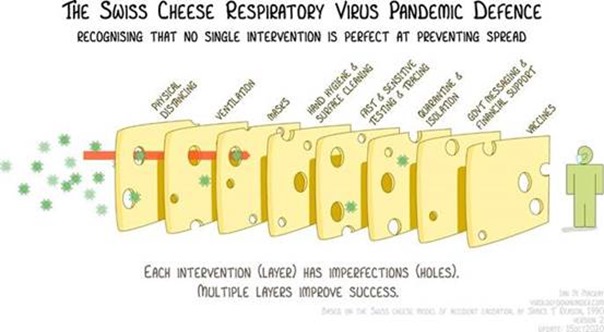When you think of Swiss Cheese, you almost always envision the holes that are present throughout the slices. They come in many unique sizes and in random locations. However, if you had a large block or stacked the slices back together, you’d rarely find a single hole that goes entirely through from one side to the other.
This obstruction of a direct path, even with the presence of multiple holes, is the basis for the Swiss Cheese model of respiratory defense as it relates to contracting or spreading Flu, COVID-19, or the common cold.
As you can see in the image, each layer of cheese represents all the different barriers that we might decide to implement to try to block the virus from having a direct path to us or others. If we only use one or two barriers, the chances of the virus getting through are greater than if we use four or more.
Combine measures to reduce the likelihood of getting sick
Even though layering multiple barriers together is the better way to approach Flu mitigation, certain barriers have been proven to be more effective themselves than others. Also, there are some that are simply a best practice to follow when you are ill and wish to minimize spreading. Below I will rank each in terms of importance.
- Vaccine. Each year, the Flu vaccine is altered to treat the prior year’s Flu as well as what Flu strain experts think might circulate this season. Flu vaccines are typically 40% to 60% effective in preventing you from getting sick. While that might not seem like a high percentage of success, if you do nothing else besides get the vaccine, you have effectively halved the rate of infection. A bonus here is that even if you do get sick, those who get the vaccine typically have reduced severity of the illness. So you get less sick.
- Physical Distancing.The simple act of increasing the space between people has a great impact on spreading airborne viruses. The reason being that the more space between you and someone else when communicating, the less opportunity for respiratory particles to find their way from person to person. There’s greater chance of the particles falling to the ground or landing elsewhere on the body than on the face.
- Ventilation. Similar to physical distancing, being in an area with more ventilation makes it harder for viruses to connect face to face. Try to be outside when you meet others or if inside, open windows to increase the ventilation. Airflow is going to move viral particles away from you and help reduce your risk of catching those viruses.
- Masks.With masks, we are trying to use materials to make it harder for viral particles to move through. This is a way to limit or dampen the amount of particles moving around when someone speaks, coughs, laughs, or sings. The more particles we can trap close to us when we are sick, the fewer particles there are floating about for other people to breath in. Ideally, you’d like to use a surgical mask or a N-95 grade mask if possible. If not, a good test is to hold your mask up to a light. The more light you see come through the mask, the less effective the mask will be at blocking viral particles. Be careful when taking off your mask, especially if you are already sick, as you could inadvertently deposit particles around.
- Hand Hygiene. When it comes to your hands, washing with soap and warm water is the better bet than using alcohol-based hand sanitizers. The duration of washing should be 20-30 seconds. For children, I like to tell them that you should be able to sing the Happy Birthday song twice.
- Testing.If you do feel like you are coming down with something, certainly talk with your doctor and ask them if testing if appropriate. Knowing your diagnosis will help you and others avoid behavior that can increase risk of transfer.
- Quarantine. Probably the most effective way to keep viruses from spreading is to avoid all contact with others. However, I do not rate this 1st because it is not always practical to do. As Americans, we always want to go back to work or school and do our part, but in a situation where you know you are sick it’s really worthwhile for you to just quarantine at home alone. In doing so, you’re going to reduce the likelihood that you are passing a virus along to others.
Putting it all together
Now that you know more about the different slices of “cheese” in the respiratory model of defense, I hope that you are better armed with multiple ways to protect yourself and others from airborne viruses.
If there has been a silver lining to the COVID-19 pandemic of 2020, I feel that it would be the increased awareness and the focus on the preventative steps above. These simple actions could also lead to an overall reduction across the board in the Flu and common cold transmission. The Southern Hemisphere, who recently came out of their Winter, saw a drastic reduction in the severity of their Flu season.
As always, take care and be safe.
If you’d like to know more or have questions, please do not hesitate to reach out to our offices directly.
To learn more about Direct Primary Care, click here.
To read more blogs from Euphora Health, click here.

